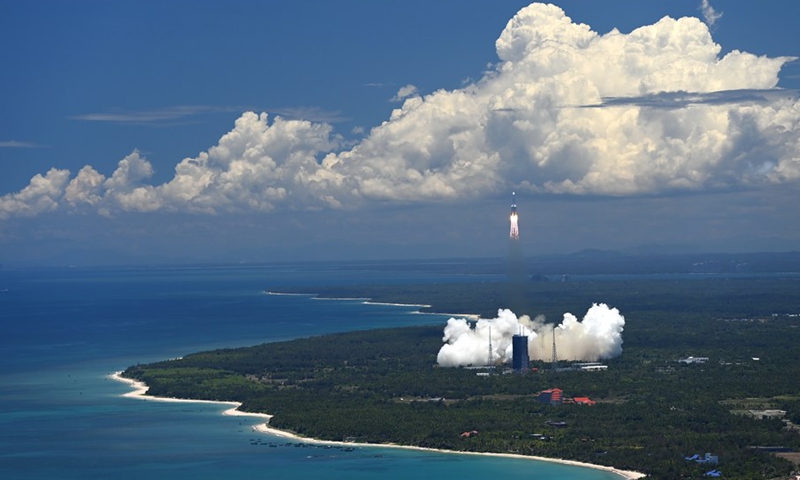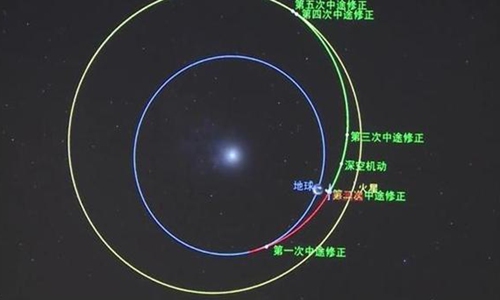'Losing access' to Swedish space facility in Australia hardly affects Chinese space programs: insiders

A Mars probe is launched on a Long March-5 rocket from the Wenchang Spacecraft Launch Site in south China's Hainan Province, July 23, 2020. (Xinhua/Guo Cheng)
After Reuters reported Monday that a space tracking facility located in Western Australia and owned by the Swedish Space Corporation (SSC) is to cut China's access to the facility when their current contract expires, Chinese space insiders said on Tuesday there is at least a decade left on the contract, and the facility has not been used or visited by relevant working personnel from China for many years.
"We can still visit and utilize the facility in Western Australia for many years to come, and even losing access to it would hardly affect China's upcoming space exploration and key manned space programs," sources very close to the Chinese space tracking system told the Global Times on Tuesday in an exclusive interview, dismissing the original report's exaggeration that the Swedish firm's decision would "cut into Beijing's expanding space exploration and navigational capabilities in the Pacific region."
Reuters reported Monday that the SSC has had a contract allowing China access to the satellite antenna at the ground station since at least 2011. The site is owned by a SSC subsidiary, SSC Space Australia.
The sources gave a clearer picture, telling the Global Times that the contract started in 2009, and is good for decades.
In fact, China will renew its collaboration with the SSC after the current contract expires, sources revealed, while declining to elaborate on the details on whether the Australian facility is still included in the collaboration.
When asked how much the potential cut-off of access to the facility would affect Chinese space development, sources said that the last time it was actually used was in 2013, during China's Shenzhou-10 manned space mission, and even then the Australia-located facility was used mainly for data transmission.
Shenzhou-10, China's fifth manned spacecraft, successfully completed an automated docking with the orbiting Tiangong-1 space module in 2013, with three Chinese astronauts aboard - Nie Haisheng, Zhang Xiaoguang and Wang Yaping.
The facility in Western Australia played a far less important role than the ground space station in Kiribati during the Shenzhou-10 mission, sources said. "The usage of the facility is next to nothing, and it has been years since Chinese space personnel last visited the facility, let alone used it."
This revelation means that the facility has not played a supporting role in the very recent milestone events in China's space sector, such as the Chang'e-4 soft landing on the far side of the moon, a first in human history, and the country's Tianwen-1 Mars probe mission.
The cooperation between China and Sweden in Australia follows international practices and China has been operating with Swedish companies on the basis of mutual benefit, Foreign Ministry Spokesperson Wang Wenbin said on Tuesday.
The Chinese government has always been committed to exploring and using outer space for peaceful purposes and attaches great importance to space cooperation with Sweden and other countries, said Wang.
Over the years, China has established a complete spacecraft tracking and monitoring system that includes ground stations across the country such as those in Beijing and Xi'an, capital of Northwest China's Shannxi Province, deep space ground stations in Jiamusi in Northeast China's Heilongjiang Province and Kashi prefecture in Northwest China's Xinjiang Uygur Autonomous Region, as well as China's first overseas deep-space ground station located in Argentina's Patagonia region.
China also has four spacecraft tracking ships in service, the Yuanwang-3, -5, -6 and -7, which conduct missions in multiple oceans across the globe.
The Reuters report also said that limited access to the overseas ground station would harm the operations of China's homegrown BeiDou Navigation Satellite System, or BDS, as it considered that "ground stations are a vital part of space programs given they create a telecommunications link with spacecraft…and they can be equipped to coordinate satellites for Global Navigation Satellite Systems (GNSS) such as Beidou and US-owned GPS."
However, BeiDou scientists and architects have taken limited access to overseas ground stations into consideration since the very beginning, and China's BDS has created unique inter-satellite links to reduce reliance on ground stations and to ensure global services with high precision at the same time.
Since the ground stations in China cannot directly track and control all the BDS satellites at the same time, the inter-satellite links help establish communication among them. Instructions sent by the ground control center to one satellite in the constellation can be transmitted to all of them through this unique technological design, experts revealed.

